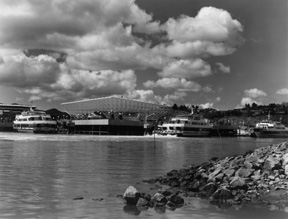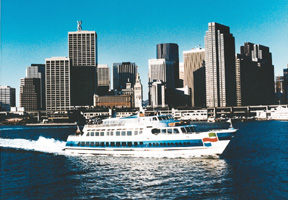Ferry News
 By
Wes Starratt, P.E.
By
Wes Starratt, P.E.
Vallejoís Fourth Ferry Awaits
Funding
Yes, Californiaís budget crisis
is affecting the Bay Areaís ferry system. The City of Vallejoís
Baylink Ferries has tentatively awarded a contract for the
construction of its Ferry #4 to Dakota Industries of Anacortes,
Washington. However, the contract cannot be finalized, since state
funding for the vessel in the amount of $5 million is in doubt due
to the budget crisis.
State Constitutional Amendment Can
Boost Transportation Funding
Keep your eye on State
Constitutional Amendment 2, which is slowly working its way through
the state legislature in Sacramento, and, if approved, will be
headed for the ballot box, possibly as early as November. The
amendment will make a profound difference in future funding for
transportation projects in California. Currently stymied by a
requirement for two-thirds voter approval mandated by the state
constitution, the amendment would reduce that requirement to a
simple majority. For example, this change in the state constitution
would facilitate voter approval of sales tax increases for
transportation projects in such Bay Area counties as Marin, Sonoma,
and Solano where past measures, although approved by majorities,
have gone down to defeat because they didnít achieve the
two-thirds threshold. The amendment would also facilitate the
approval of transportation-related sales tax measures in other Bay
Area counties when they come up for renewal and require a two-thirds
voter approval. In addition, the majority threshold would apply to
the Metropolitan Transportation Commissionís existing authority to
seek voter approval of a regional gasoline tax for the San Francisco
Bay Area. The bottom line is that approval of Constitutional
Amendment 2 will mean less congestion and better transit and ferry
service for the entire Bay Area.
511 Traveler Information
Service Expanding
Try calling 511 for a
voice-activated, information phone service that is being activated
in stages nationwide. The Bay Areaís development of the phone
service is the result of a partnership between the Metropolitan
Transportation Commission (MTC), Caltrans, the California Highway
Patrol, and dozens of regional transit operators. MTC began adapting
the 511 phone system to the Bay Areaís needs over a year ago when
the Federal Communications Commission granted the exclusive use of
the 511 phone number to state and local transportation departments
to disseminate traveler information.
Today, the Bay Area is the largest
metropolitan area in the country and the first in California to
offer the free phone service. Based at Caltrans District 4
headquarters in Oakland, the 511 data-collection team taps into
numerous sources of information on traffic conditions throughout the
nine-county region. The system also provides links to phone
information centers of local public transit and ride-sharing
agencies. In addition, information is provided on bicycling and
airport access and parking. The number of 511 calls is averaging
3,500 per week. MTC has established a companion website, www.511.org.
Now hearing- and speech-impaired
people can use the 511 information service by dialing another
easy-to-remember number, 711. This development is the result of a
partnership between MTC and the California Relay Service, which
operates the 711 service.
New Members of Golden Gate Bridge
District Board
Four new members have recently
been appointed to the Board of Directors of the Golden Gate Bridge,
Highway & Transportation District.
From the Marin County Board of
Supervisors, Supervisor Cynthia Murray has replaced former
Supervisor John Kress. Supervisor Murray has made transportation her
top priority, serving as chair of the Marin/Sonoma Narrows Policy
Advisory Group and as a member of the Water Transit Authorityís
Citizen Advisory Committee.
From San Francisco, three new
representatives were appointed to the board: San Francisco
Supervisors Jake McGoldrick and Sophie Maxwell, and public
representative Janet Reilly. Both supervisors McGoldrick and Maxwell
are members of the San Francisco County Transportation Authority.
 As
the Golden Gate Bridge District Faces Reduced Ridership and Increase
Costs, Are Increased Fares and Reduced Service the Only Answers?
As
the Golden Gate Bridge District Faces Reduced Ridership and Increase
Costs, Are Increased Fares and Reduced Service the Only Answers?
The economic downturn has dealt
the Golden Gate Bridge, Highway & Transportation District a
severe blow at a time when the costs of maintaining the bridge are
mounting. The answer appears to be a restructuring of bus service,
particularly in Marin County, as well as a greater emphasis on
high-speed ferries, possible reduction of ferry service to
Sausalito, and increased fares.
Looking at costs, the Golden Gate
Bridge, which turned 65 in 2001, is facing a multi-million dollar
rehabilitation of the main cables and the roadway under-decking at a
time when federal funding is greatly reduced. The threat of
terrorism has led to a significant rise in expenses for crucial
services, including security and insurance.
Looking at income, recent bus
transit ridership has decreased by 7.7 percent, ferry ridership is
down by 2.5 percent, and bridge traffic is down 2.7 percent.
By the end of 2001, the district
made its first move toward bringing its projected five-year
shortfall of $202 million into balance by increasing bridge tolls
for the first time in 11 years. It should be noted that one half of
those tolls is used to subsidize bus and ferry service, while the
other half is used for the bridge and general administration.
This was only the first step.
Without an improving economy and with continuing threats of
terrorism, it has become evident that further steps must be taken.
The focus has been on decreasing bus and ferry operating expenses
without further decreasing ridership. Under consideration are
service cuts currently being discussed and expected to be announced
on March 9/10, with a possible second round of cuts in September.
The emphasis will be on bus service.
The staff of the Bridge District
also has proposed an "interim" program effective this July
for fare increases of 5 percent on all buses, but with a higher
percentage increase for ferries to bring them into "greater
parity with the fares in the Bay Area market." Thus, for
example, from Larkspur, one-way commuter fares would increase from
$2.60 to $3.50; and from Sausalito, one-way commuter fares would
increase from $2.12 to $3.00, with comparable increases for other
fares. There will be a public hearing on or about April 2, with
public comments to the Districtís Finance-Auditing Committee on
April 24, for final approval and implementation on July 1.
 For
the ferry service, greater use is expected to be placed on
high-speed ferries, starting this summer, after the Mendocino has
been returned to service and the Del Norte has undergone
dry-docking in Alameda for routine maintenance.
For
the ferry service, greater use is expected to be placed on
high-speed ferries, starting this summer, after the Mendocino has
been returned to service and the Del Norte has undergone
dry-docking in Alameda for routine maintenance.
Efforts are underway to completely
restructure bus service and to provide improved coordination with
ferry service. It is anticipated that express bus service to San
Francisco would be reduced, especially during mid-day, and that
increased service would be provided to connect with mid-day ferry
service at Larkspur Landing. And, as the number of tourists
continues to decrease, there has been talk about drastically
reducing the Sausalito ferry service.
A five-year fare increase program,
slated for implementation in July 2004, will be developed over the
next 12 months. It will be designed to maintain a fare-box recovery
for bus and ferry service of 33%. In other words, a level at which
the passengerís fare actually pays 33 percent of the cost, while
the balance is subsidized by bridge tolls and other means.
These efforts by the Bridge
District are being coordinated with Marin County, which currently
subsidizes much of the in-county bus service provided by the Bridge
District. The county has never considered subsiding the ferries or
anything beyond in-county services. As the county looks toward a
possible sales tax measure on the November ballot, however, there is
a possibility that it might also consider subsidizing shuttle bus
service to Larkspur Landing.
Next month, we will focus our
attention on Marin County and the Sonoma Marin Area Rail Transitís
(SMART) proposed rail system from Sonoma County to Port Sonoma
and/or a Marin destination, possibly San Rafael, Larkspur Landing,
or even a new ferry terminal at San Quentin.